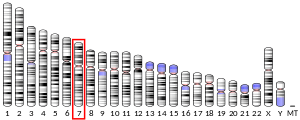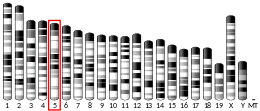LFNG
LFNG O-fucosylpeptide 3-beta-N-acetylglucosaminyltransferase, also known as LFNG and Lunatic Fringe,[5][6] is a human gene.[7]
This gene encodes a member of the glycosyltransferase superfamily. The encoded protein is a single-pass type II Golgi membrane protein that functions as a fucose-specific glycosyltransferase, adding an N-acetylglucosamine to the fucose residue of a group of signaling receptors involved in regulating cell fate decisions during development. Mutations in this gene have been associated with autosomal recessive spondylocostal dysostosis 3. Alternatively spliced transcript variants that encode different isoforms have been described, however, not all variants have been fully characterized.[7]
Function
Lunatic Fringe (Lfng) is a gene whose role in embryonic development is to establish the anterior boundary of somites, which will eventually develop in vertebrae, ribs, and dermis.[8] Lunatic Fringe responds to certain threshold ratios of retinoic acid and FGF-8 in order to mark the anterior boundary of somites while another transcription factor, Hairy, responds to different threshold ratios of retinoic acid and FGF-8 to form the posterior boundaries of somites.[9]
Clinical significance
A defect associated with Lfng mutations is spondylocostal dysostosis. Spondylocostal dysostosis is characterized by segmentation problems in the developing vertebrae resulting in fusion or lack of vertebrae along with abnormalities in the ribs.[10] Clinically, spondylocostal dysostosis presents as a shortened neck and trunk relative total height and a mild form of scoliosis. Respiratory problems are also common in spondylocostal dysostosis because of the shortened trunk.
A knockout model for Lfng has been created in mice, and without Lfng, mice have shorter tails, and impaired rib, lung, and somite development. A deficiency of Lfng in male mice has also been associated with lack of spermatozoa in the epididymis of many mice; however, spermatogenesis was not impaired. Rather, the male mice were subfertile.[11] In female mice, Lfng deficiency led to infertility because of abnormal folliculogenesis. Further examination showed that oocytes from these female mice did not complete meiotic maturation.[12] However, there are other studies that contradict this stating that not all female mice deficient of Lfng are infertile. A possible explanation for this difference between these studies is that the Lfng alleles were functional different, however, this is unlikely. More likely is that this discrepancy results from differences in the genetic background of the mice or husbandry and colony conditions.[13]
Impact of mutation
Lunatic Fringe is a transcription factor that plays a crucial role in the development of the somites. Somites give rise to the skeletal muscle, the axial skeleton, the tendons, and the dorsal dermis. The somites are formed via the clock-wave front model, and as each somite is formed, each cell receives a burst of FGF8 (a signaling molecule). Somites are formed anterior to posterior, and since FGF8 has a short half-life, this leads to a greater concentration of FGF8 in the posterior, and a lesser concentration in the anterior. Lunatic fringe responds to the lower concentration of FGF8 in the anterior and leads these cells to their developmental fate. Mutation of the Lunatic Fringe gene can cause severe Spondylocostal Dysostosis, which involves vertebral segmentation defects and rib abnormalities. A mutation was discovered in which a conservative phenylalanine close to the active site of the enzyme mutates, leading to the enzymatic inactivation of Lunatic Fringe. A “knock-out” model has been created using mice. In mice, Lunatic Fringe plays a crucial role in the Notch signaling pathway during the formation of somites, and a mutation in this gene leads to somites with irregular shapes and a defect in the anterior-posterior formation.
References
- GRCh38: Ensembl release 89: ENSG00000106003 - Ensembl, May 2017
- GRCm38: Ensembl release 89: ENSMUSG00000029570 - Ensembl, May 2017
- "Human PubMed Reference:". National Center for Biotechnology Information, U.S. National Library of Medicine.
- "Mouse PubMed Reference:". National Center for Biotechnology Information, U.S. National Library of Medicine.
- Egan S, Herbrick JA, Tsui LC, Cohen B, Flock G, Beatty B, Scherer SW (December 1998). "Mapping of the human Lunatic Fringe (LFNG) gene to 7p22 and Manic Fringe (MFNG) to 22q12". Genomics. 54 (3): 576–7. doi:10.1006/geno.1998.5559. PMID 9878264.
- "Troublesome gene names get the boot", 6 November 2006, Michael Hopkin, nature.com
- "Entrez Gene: LFNG LFNG O-fucosylpeptide 3-beta-N-acetylglucosaminyltransferase".
- Serth K, Schuster-Gossler K, Cordes R, Gossler A (April 2003). "Transcriptional oscillation of lunatic fringe is essential for somitogenesis". Genes & Development. 17 (7): 912–25. doi:10.1101/gad.250603. PMC 196028. PMID 12670869.
- Shifley ET, Vanhorn KM, Perez-Balaguer A, Franklin JD, Weinstein M, Cole SE (March 2008). "Oscillatory lunatic fringe activity is crucial for segmentation of the anterior but not posterior skeleton". Development. 135 (5): 899–908. doi:10.1242/dev.006742. PMID 18234727.
- Sparrow DB, Chapman G, Wouters MA, Whittock NV, Ellard S, Fatkin D, Turnpenny PD, Kusumi K, Sillence D, Dunwoodie SL (January 2006). "Mutation of the LUNATIC FRINGE gene in humans causes spondylocostal dysostosis with a severe vertebral phenotype". American Journal of Human Genetics. 78 (1): 28–37. doi:10.1086/498879. PMC 1380221. PMID 16385447.
- Hahn KL, Beres B, Rowton MJ, Skinner MK, Chang Y, Rawls A, Wilson-Rawls J (January 2009). "A deficiency of lunatic fringe is associated with cystic dilation of the rete testis". Reproduction. 137 (1): 79–93. doi:10.1530/REP-08-0207. PMC 5739036. PMID 18801836.
- Hahn KL, Johnson J, Beres BJ, Howard S, Wilson-Rawls J (February 2005). "Lunatic fringe null female mice are infertile due to defects in meiotic maturation". Development. 132 (4): 817–28. doi:10.1242/dev.01601. PMID 15659488.
- Xu J, Norton CR, Gridley T (February 2006). "Not all lunatic fringe null female mice are infertile". Development. 133 (4): 579, author reply 579–80. doi:10.1242/dev.02221. PMID 16436621.
- Zhang N, Gridley T (July 1998). "Defects in somite formation in lunatic fringe-deficient mice". Nature. 394 (6691): 374–7. doi:10.1038/28625. PMID 9690472.
Further reading
- Johnston SH, Rauskolb C, Wilson R, Prabhakaran B, Irvine KD, Vogt TF (June 1997). "A family of mammalian Fringe genes implicated in boundary determination and the Notch pathway". Development. 124 (11): 2245–54. PMID 9187150.
- Moran JL, Johnston SH, Rauskolb C, Bhalerao J, Bowcock AM, Vogt TF (June 1999). "Genomic structure, mapping, and expression analysis of the mammalian Lunatic, Manic, and Radical fringe genes". Mammalian Genome. 10 (6): 535–41. doi:10.1007/s003359901039. PMID 10341080.
- Moloney DJ, Panin VM, Johnston SH, Chen J, Shao L, Wilson R, Wang Y, Stanley P, Irvine KD, Haltiwanger RS, Vogt TF (July 2000). "Fringe is a glycosyltransferase that modifies Notch". Nature. 406 (6794): 369–75. doi:10.1038/35019000. PMID 10935626.
- Shimizu K, Chiba S, Saito T, Kumano K, Takahashi T, Hirai H (July 2001). "Manic fringe and lunatic fringe modify different sites of the Notch2 extracellular region, resulting in different signaling modulation". The Journal of Biological Chemistry. 276 (28): 25753–8. doi:10.1074/jbc.M103473200. PMID 11346656.
- Cole SE, Levorse JM, Tilghman SM, Vogt TF (July 2002). "Clock regulatory elements control cyclic expression of Lunatic fringe during somitogenesis". Developmental Cell. 3 (1): 75–84. doi:10.1016/S1534-5807(02)00212-5. PMID 12110169.
- Shao L, Moloney DJ, Haltiwanger R (March 2003). "Fringe modifies O-fucose on mouse Notch1 at epidermal growth factor-like repeats within the ligand-binding site and the Abruptex region". The Journal of Biological Chemistry. 278 (10): 7775–82. doi:10.1074/jbc.M212221200. PMID 12486116.
- Oh JH, Yang JO, Hahn Y, Kim MR, Byun SS, Jeon YJ, Kim JM, Song KS, Noh SM, Kim S, Yoo HS, Kim YS, Kim NS (December 2005). "Transcriptome analysis of human gastric cancer". Mammalian Genome. 16 (12): 942–54. doi:10.1007/s00335-005-0075-2. PMID 16341674.
- Sparrow DB, Chapman G, Wouters MA, Whittock NV, Ellard S, Fatkin D, Turnpenny PD, Kusumi K, Sillence D, Dunwoodie SL (January 2006). "Mutation of the LUNATIC FRINGE gene in humans causes spondylocostal dysostosis with a severe vertebral phenotype". American Journal of Human Genetics. 78 (1): 28–37. doi:10.1086/498879. PMC 1380221. PMID 16385447.




